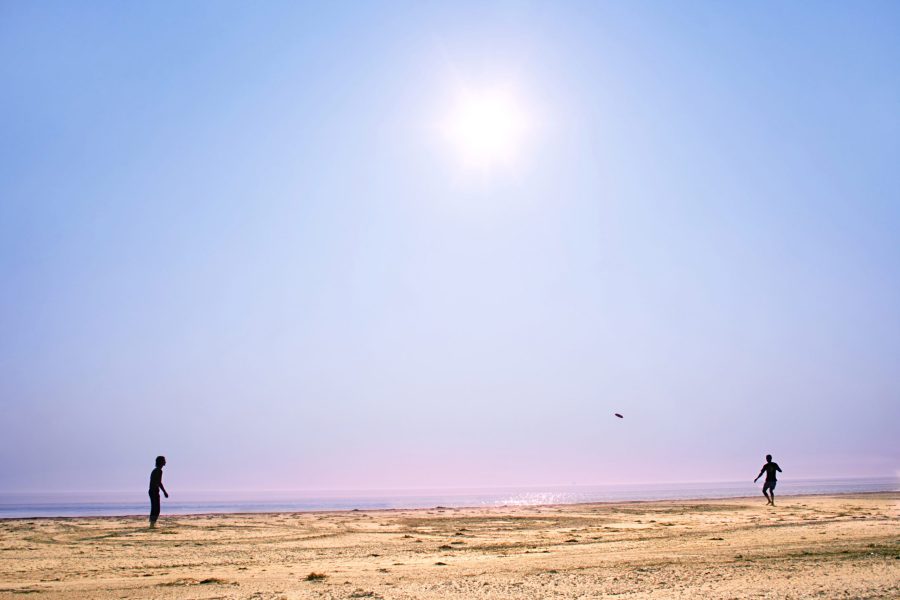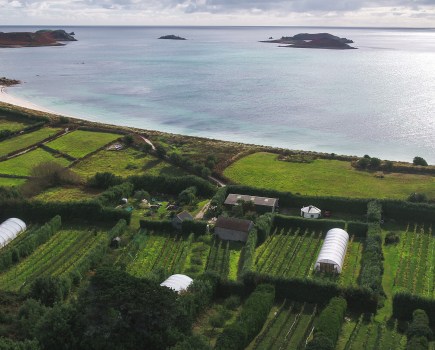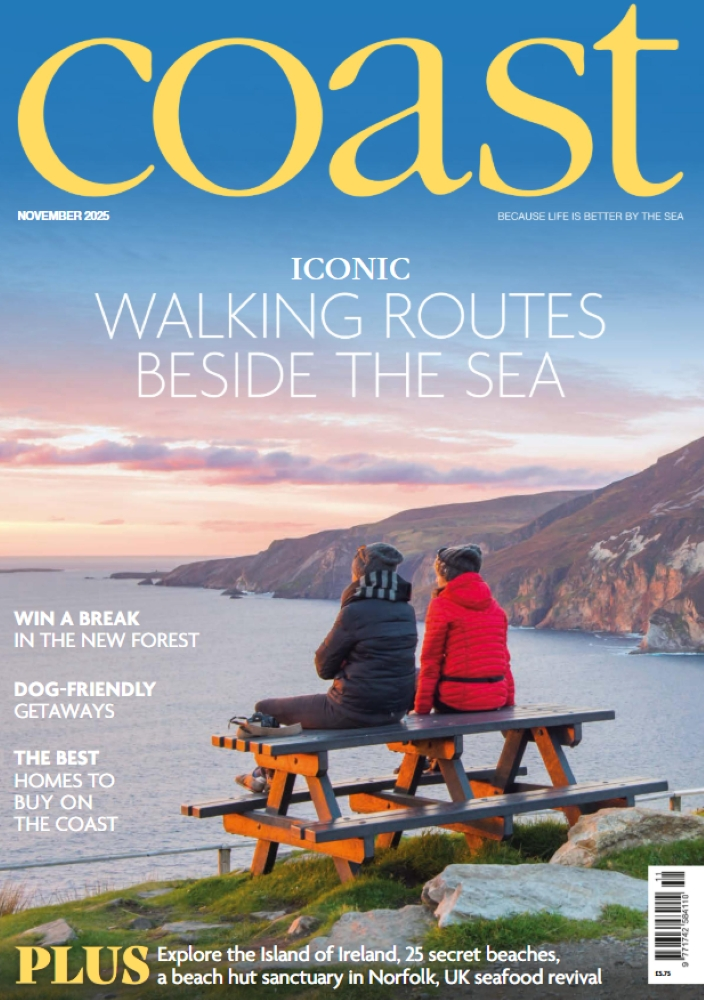With a bit of guidance you can become a pro at Frisbee-throwing, as our writer Mark Hillsdon discovers on a sun-drenched day in Tynemouth, North Tyneside.
For anyone who grew up in the Seventies, being able to send a disc of plastic skimming through the air, without it wobbling and flapping like a drunken duck, was something of a rite of passage. The Frisbee originated in the US 100 years earlier, when students began throwing the lids of pie tins made by a Connecticut company called Frisbie. In the Fifties the Wham-O Corporation changed the name to Frisbee, and a new craze was born.
There is now a host of disc sports, including golf, when, as with the ‘normal’ game, the object is to complete each ‘hole’ in as few shots as possible. The holes are, in fact, specially designed baskets and there are permanent Frisbee golf courses all over the UK, with many in coastal towns, and a thriving competitive circuit, too. Ultimate Frisbee is a non-contact team sport with links to American Football, while in Discathon, runners complete a course throwing two discs alternately. But the real beauty of Frisbee is that all you need is a bit of space and you’re away. And the great beaches along our coastline, together with the forgiving nature of sand when you crash-land trying to make a catch, makes this the perfect arena. So, to hone my technique, I meet up with old friend Joe Durkin on the immaculate Longsands Beach at Tynemouth, North Tyneside. Mitzi the dog is also along for the ride.
We’re here to enjoy a masterclass with the former British amateur disc golf champion, Chris O’Brien, who’s developed a successful business around the Frisbee, running an online shop and a variety of training courses. ‘It’s a great leveller,’ he says, ‘and within a few hours you can be quite good.’ Only time would tell.
11AM
It’s all in the wrist
A quick brew at Crusoe’s Café, a couple of (half-hearted) stretches and we start with the basics. The backhand is your standard throw. A fan grip involves holding the rim of the Frisbee and then spreading your fingers out underneath.
This gives more control. For power, keep the fingers locked in a fist. Once you can send the disc ten or so yards without a wobble, put a bit more effort in, pivoting the body and really flinging the arm out as you release. The forehand throw feels more awkward at first. Place the thumb on top and three fingers under the disc, with the little finger pressed on the outside of the rim. Then, keeping your elbow tucked in, you flick the disc forward using your wrist. ‘It’s not quite as easy as it looks,’ says Chris. ‘A lot of the technique is between the ears.’
11.45AM
Hole in one
With varying degrees of success, we’re now able to play a game of catch. But we still need to work on direction. The idea is to try to release the disc when it’s flat and level with the ground. ‘Think of it as a plane,’ Chris explains. ‘If the wings are tilted to the left or to the right, the plane will turn the same way.’ Joe and Chris start a game of KanJam, a new Frisbee product from America, and even Chris is still a novice. It’s ideal for the beach, with two black plastic collapsible ‘cans’, each about a metre high, set 30 metres apart.
They have a slit in the front like a postbox and one of the many ways to score points is to get the disc straight in. And, incredibly, Chris does just that with only his third throw and is genuinely delighted. ‘I’ve never seen that done before,’ he beams.
12.30PM
It’s catching
That’s the throwing ‘mastered’, now for the catching. Maximum Time Aloft (MTA) involves throwing the disc high so that the wind brings it back arching towards you. All you have to do then is catch it. It’s another perfect beach game because you can fling the disc out to sea, then let the wind blow it back. The world record holder made the disc hang on the breeze for over 16 seconds before making the catch. We manage rather less.
1.15PM
A little bit of TRC
‘Throw, Run and Catch (TRC) is for people who like sprinting,’ says Chris, which rules us out for starters.
You need to launch a long, hovering throw before setting off in pursuit to catch the disc. The distance is measured from the point of release and although we don’t get too close to the world record of 96 metres, Chris’s tuition is definitely improving our technique. By now, however, I can feel the first tweaks of what I dub ‘Frisbee elbow’ coming on.
2PM
Time for a paddle
Next we try Forceback, when two players use one Frisbee to either force their opponent down into the sea or up into the sand dunes. With the wind behind me, and throwing down the beach, Joe soon has me wading around in the shallows.
2.30PM
Dog days Disaster
Mitzi has just chewed up one of Chris’s discs, although thankfully it’s not his pride and joy, a disc given to him by a former golf world champion which is capable of flying for more than 130 metres. A professional disc golfer will carry as many as 15 discs with them, including a range of ‘drivers’, ‘approaches’, and ‘putters’, all with different characteristics and many with fanciful names such the Predator, Destroyer and Excalibur.
3PM
Let the battle commence
It had to get competitive in the end, so we finish with a three-event tournament. I take the MTA with a rather tame 2.3 seconds, while Joe outdoes me with a power throw of 60 metres, which means it’s all down to six holes of disc golf.
We soon improvise a course, which involves drawing ‘hazards’ in the sand, swerving around obstacles such as bins, and starting from a lofty ‘tee’ up in the dunes. We also break out one of Chris’s custom-built ‘catchers’, but any target will do, he says, with old lobster pots a particular favourite.
3.30PM
Bunkered
It’s all square until the third hole, when Joe’s first shot flies wildly off to the right. I get down in three, one less than Joe. We both complete the fourth hole in three (Chris, by the way, is calmly taking just two shots on each) but then on the fifth, Joe fluffs his approach, leaving me two up with one to play.
As part of the final hole, we must use a forehand throw to go round the right-hand side of a post. Joe produces an absolute peach, while my tee shot, after much rancorous debate, is judged to have gone to the left of the pole, giving me a one-shot penalty. My game falls apart and I suddenly see my lead evaporate, taking six shots to hole out, while Joe completes another three to take the first, and possibly last, Tynemouth Disc Golf Open. Chris runs a range of courses, including sessions for groups of friends based around two hours of tuition and a game of Disc Golf, or a series of Throw and Catch events. Prices start at around £35 per person. He also runs structured courses for people interested in teaching Frisbee and you will find tutorials on his website. Visit catchthespirit.co.uk or call 07977 216355.
Watch the pros
Ali Findlay, from Brighton, East Sussex, is a founder member of the Brighton Ultimates team and a regular on the UK’s disc golf circuit.
‘I first started playing Ultimate when I was at university in Sussex in 1996. Brighton’s always been a hotbed for disc sports: the city’s other Ultimate team, the Mohawks, have been going for 25 years and are the UK’s indoor and outdoor champions. You do have to be pretty fit to play, though, so as I got older I got interested in disc golf. ‘There are some great coastal courses in the UK because you get such a varied terrain by the sea. One of the most beautiful – and the most difficult – is on the Isle of Mull, which looks out over the Atlantic. The wind can gust up to 25mph an hour, which can make playing quite difficult!’
Need to know
What you need to get started
To find out more about disc golf, contact the British Disc Golf Association at bdga.org.uk. The website details competitions and courses across the whole country, including a course on top of Constitution Hill, Aberystwyth, overlooking the Irish Sea, a clutch of courses in Eastbourne, and a nine-hole course at Garth Hall Park in Hornsea, East Yorkshire. Many universities run Ultimate Frisbee teams. For details, visit ukultimate.com.
What it costs
Discs range from between £7.95-£14.95 each. If you do get the bug, you’ll need at least six discs, as well as a bag to carry them in, which ranges from £12 to £49, while KanJam sets retail at £38.50. All items are available from catchthespirit.co.uk. No special clothing is required, just run-of-the-mill beachwear is fine.
Where to stay
Martineau House, 57 Front Street, Tynemouth martineau-house.co.uk. Named after Harriet Martineau, acclaimed novelist and England’s first female journalist, this deluxe B&B has four en-suite rooms, all of which retain period features, such as open fireplaces. They also offer great views out over the Tynemouth Priory and the mouth of the River Tyne. Breakfast includes North Shields kippers, as well as a veggie option. For an incredible range of cakes and a superb beachside location, try Crusoe’s Café.







